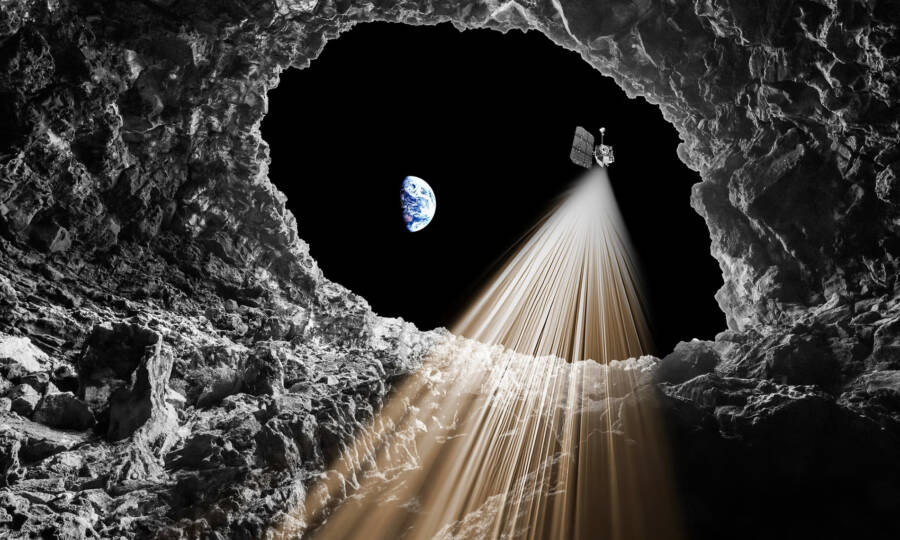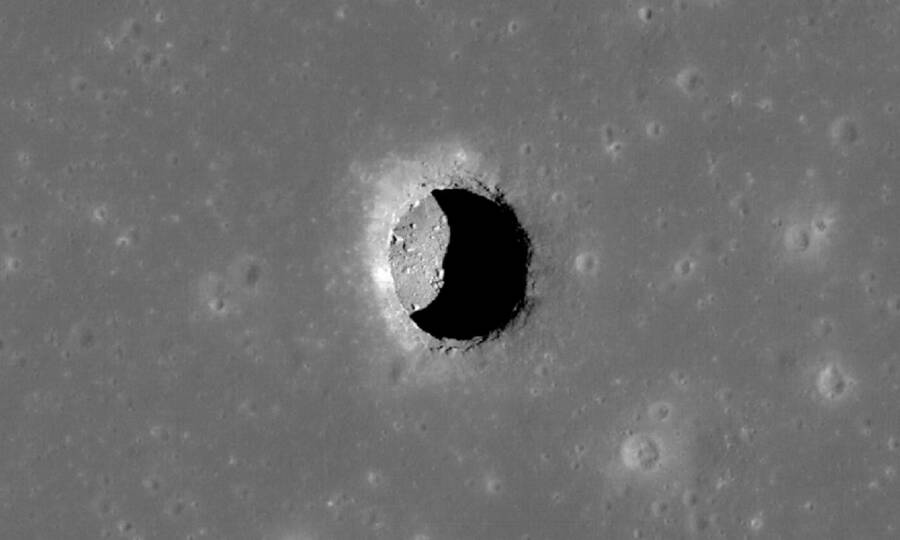This cave could one day serve as an ideal location for a lunar base, as it would help shelter astronauts from the moon’s harsh conditions.

NASAAn artist’s rendition of the moon tunnels.
For more than 50 years, scientists have hypothesized that there may be a network of lava tunnels beneath the moon’s surface. Now, using advanced image processing technology, researchers from the University of Trento in Italy have uncovered the first evidence that one of the moon’s approximately 200 known surface pits connects to a deep underground cave.
Researchers now hope that future studies will explore the possibility of human habitation in these lunar tunnels.
Researchers Examine Old Evidence With New Techniques

NASA / GSFC / Arizona State University The Mare Tranquillitatis pit crater, where the cave was identified.
Originally hypothesized 50 years ago, lunar tunnels have long been the subject of debate in the scientific community. In 2009, scientists discovered an unusually deep pit on the moon’s surface, offering support for the possibility of a hidden network of lava tunnels. But it wasn’t until this year that researchers published concrete evidence of a lunar pit connecting to a deeper channel.
Just recently, researchers from the University of Trento in Italy applied new technology to scans of the moon’s surface taken from NASA’s Lunar Reconnaissance Orbiter in 2010. Using advanced signal processing analysis techniques, the team reanalyzed scans taken of a pit within the moon’s Mare Tranquillitatis region — and determined that it connects to a deep underground tunnel.
“Thanks to the analysis of the data we were able to create a model of a portion of the conduit,” Leonardo Carrer, a researcher at University of Trento, stated in a translated press release. “The most likely explanation for our observations is an empty lava tube.”
This newly discovered cave measures about 148 feet wide and between 98 and 262 feet long, though scientists believe it could be part of a system that extends even deeper beneath the moon’s surface.
“These structures had been hypothesized for over 50 years,” Lorenzo Bruzzone, coordinator of the research, said in the press release. “But this is the first time ever that we have demonstrated their existence.”
Moon Tunnels As A Future Home For Humanity

University Of TrentoA 3D model of the underground tunnel.
According to the researchers’ study, these lunar tunnels may serve as the perfect base for future explorers.
“This discovery suggests that the [Mare Tranquillitatis pit] is a promising site for a lunar base, as it offers shelter from the harsh surface environment and could support long-term human exploration of the Moon,” the authors wrote.
The moon is an extremely inhospitable environment, both for humans and for machines. During the day, the moon can reach temperatures of 260 degrees Fahrenheit. During the weeks-long lunar nights, temperatures can reach -280 degrees.
The moon also experiences solar and cosmic radiation 150 times stronger than that on Earth, and faces increased risk of meteorite strikes. These factors pose major risks to any future human operations on the moon.
However, the discovery of lunar tunnels provides an intriguing remedy for this problem. Future explorers could shield themselves from space debris, radiation exposure, and unsafe temperatures by setting up operations underground.
With this hope in mind, researchers expressed the importance of further analysis of the moon’s underground caves.
“Radar tests of lunar tunnels therefore become extremely important to deepen knowledge on the extension and shape of the conduits in view of the exploration of lunar caves through future robotic missions,” they explained in the press release.
After reading about the lunar tunnels, dive into the true story of Jack Parsons, the NASA jet expert who moonlighted as a leader of a sex cult. Then, view 28 stunning images of our universe from the James Webb Telescope.





